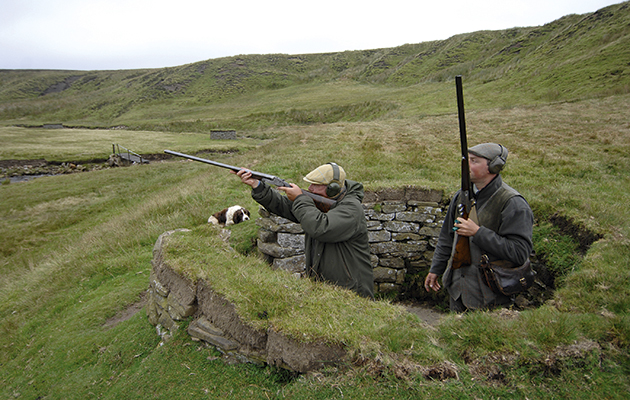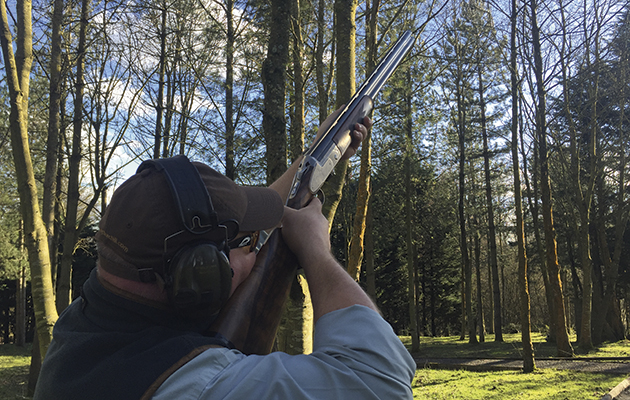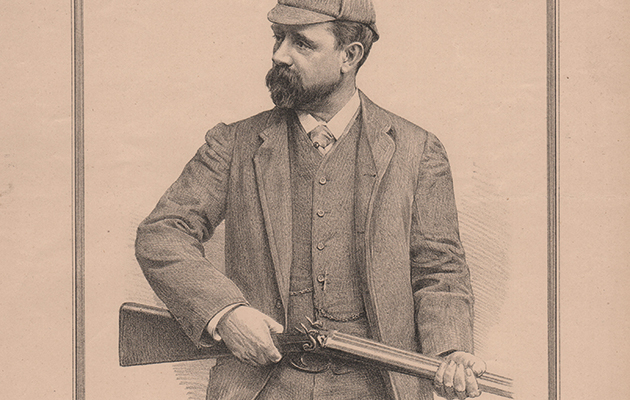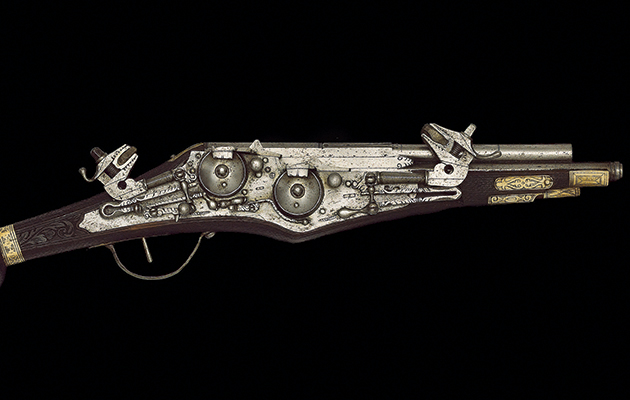Jonathan Young gives his opinion on the age-old debate and whether to use an over and under or side by side.
The choice between over and under or side by side shotgun will be forever open for debate. While tradition has favoured side by sides, an over and under will not receive the snide comments on a shoot as it once did thirty years ago. In fact, many guns find they shoot better with stacked barrels. So which is your preference? (Read: experts have their say on over and unders vs side by sides.)
Thirty years ago proper shooting types deployed a gentleman’s gun, which was a side-by-side, preferably inherited, old and English.
This explains the conversation I had after back-gunning an extremely experienced 60-days-a-season man who’d just despatched every single bird with unusual ruthlessness. “Well, I wasn’t going to let any through to someone using one of those,” he said, with a dismissive glance at my over and under. (Read: the enduring appeal of the side by side shotgun.)
Actually I love side by sides and always regret selling my first double, a snaky Army & Navy hammer gun with exquisite wood and honourable scars. But I simply shoot better with over and unders. And so do many others. An extraordinary number of my friends, after 30 plus years in the field, are now swapping to vertical barrels having seen a distinct improvement in their performance.
A few seasons ago I watched one such artist drop four wild grey partridges with four shots with a pair of 1880s sidelocks and have often witnessed a local line of experts, armed with English 12s spitting an ounce of 7s, barely miss a string of genuine 45yd pheasants – the type of bird that has so many of the over and under boys hurling 36g of 4s – and kill them dead. But these are exceptional shots whose skills have been honed by a shooting lifetime of 50 to 100 days a season. And while most of them use traditional, 61⁄2lb game-guns, an increasing number of top shots are ordering side-by-sides more akin to the old live-pigeon guns – 7lb, 30in barrels, semi-pistol grip, 23⁄4in chambers, raised rib – with the modern refinements of Teague chokes and recoil systems, the sort of guns described by one shooting coach as “the closest you can get to a modern over and under without it actually being one”. (Read more on chokes here.)
The advantages of stacked barrels
Why is every serious clay-shooting competition, including the Olympic disciplines, won by those using stacked barrels? Is it because it has inherent technical advantages that cannot be matched by a side by side?
A panel of shooting experts was asked to comment on the following qualities commonly associated with over and unders.
- They have a single sighting plane – but why does that work when so often we’re not conscious of seeing the barrels when we shoot?
- They are heavier – so more akin to the old 30in-barrelled side-by-sides shot by Ripon and Walsingham and live-pigeon competition guns – and so provide more inertia for the swing and better absorption of recoil.
- They have big fore ends, single triggers and pistol grips, so hand placement is more accurate and consistent.
- They tend to have 23⁄4in or 3in chambers, allowing them to cope with a wide range of loads including steel.
- The recoil is felt differently, so the first barrel recoil is low in the shoulder, producing less barrel flip than a side-by-side and thus allowing a far more accurate second shot.
Shooting instructor Mark Marshall says of the question: “All these points are valid. Gun fit is definitely more important with the side-by-side: 1⁄4in too short and you get bruised on your middle finger, 1⁄4in too long and you get a bruise on your arm. Cast is also more important on a side-by-side as it’s harder to see if you are centre or not. As for ‘pointability’, if I gave someone a ruler to point at something accurately I guarantee they will subconsciously turn it on edge. After all, we point a shotgun, we don’t aim it, and I think this is a major reason for the over and under’s success.
“So for me the reason most shoot better with an over and under comes down to pointability and comfort,” says Marshall, “And the fact they have probably shot in the past with badly fitted side by sides. However, there is nothing wrong with a well-fitted, 30in-barrelled side by side as long as you don’t need to fire loads heavier than 30g.”
Professional opinion
Instructor Steve Rawsthorne says of the debate: “There is no doubt that the vast majority of shooters shoot better with an over and under than a side by side. If it weren’t so, all competitive shooters would be using side by sides, rather than having a separate ‘handicap’ class for them. When I started shooting in 1967, it was with a side by side as that was all that was around. I remember the first over and unders I saw in 1970, a couple of Miroku skeet guns with 26in barrels, and they were the subject of much curiosity.”
“The modern over and under is a tool designed for the job,” continues Rawsthorne. “Ideally, firing the lower barrel first, it delivers the recoil lower into the shoulder than a side by side and in a straight line, producing less ‘felt’ (perceived) recoil so that one is on to the second shot more quickly and smoothly. The extra weight of an over and under translates into less perceived recoil, too. The pistol grip, usually with a single selective trigger, means that the rear hand is at a more natural angle compared to the hand position created by the straight-hand stock of the classic British side by sides, which cocks the wrist of the rear hand at an unnatural angle. The fore-end of an over and under gives the leading hand – which should be controlling the gun throughout the mount and shot – something to grip, as opposed to a side by side where one is holding the barrels. (Too often one sees a shooter with his fingers over the barrels of a side by side, causing him to lift the head to see over them, so shots will go high on a quartering, crossing or going-away bird. And having the head off the stock will cause more recoil-induced pain and often flinching, which is difficult, time consuming and thus expensive to cure.)
“The single sighting plane of the over and under leads the eye more naturally towards the target, rather than the double expanse of barrels and rib of a side by side,” says Rawsthorne. “And while one should not be looking at the barrels during the shot, one needs to be aware of them in the peripheral vision while the central focus is on the target; the barrels of an over and under obscure less of the target and surrounding area.
“So many shooters today are using a geriatric side by side which does not fit them, smacks them around with heavy loads (32g-plus) for high birds, which they were never designed to be used with, and are often not proofed for. Those same shooters, spending far less on a game of golf, will buy the latest carbon fibre clubs but will not buy a decent gun.”
Looking at the barrels, not the bird
Ian Coley coached the 2012 Olympic shooting team and runs one of the UK’s leading gunshops and shooting grounds. “Over the past 30 years the side by side market has been decreasing. A lot of this is down to the new, modern over and unders being so much easier to shoot and, most importantly, more pleasant to shoot in terms of recoil. (Read more on recoil here.)The typical side by side tends to be lighter, which was fine when the main cartridges used were Eley Impax 28g 6s. These are smooth and soft cartridges to shoot and were more than suitable for shoots 25 to 30 years ago. But many shoots today provide high, challenging birds and a standard 21⁄2in 28g No 6 cartridge won’t have the killing consistency at longer range provided by the modern, high-performance 23⁄4in cartridge such as Hull’s High Pheasant Extreme, Gamebore’s Black Gold and RC Sipe. Very few side by sides would be chambered and suitable for these modern-day cartridges and if they are proofed and have adequate chamber sizes for these, the recoil is too much to bear over a day of firing 250-plus cartridges,” he says.
“With over and unders, you have a full pistol grip and the majority now are multi-choked. This all helps towards the handling and performance of the gun,” continues Coley. “A full pistol grip will ensure your hand is in the suitable position and at the right angle. Whereas, with a straight-hand stock, if you mounted the gun 10 times, six of them would have your hand in a slightly different place. A few gun manufacturers are now bringing out side by sides with full pistol grips, beavertail fore-ends, single triggers and multi-chokes. These are as close as you can get to over and unders while remaining a side by side. I did have a pair of these for a bit of fun game-shooting and had great success with them; however, I never performed quite as well with them as I do with my over and unders. The control and balance was never quite the same. With shooting in general, it all comes down to marginal gains and using the right and most effective tool for the job. Shooting and shotguns have changed so much over the past few years and the mechanics and performance of shotguns is now at an all-time high.”
Eyes and barrel conformation
Edward Watson of Dr Watson Shooting adds another factor in the over and under’s favour: the relationship between eyes and barrel conformation. “Shooting is very much a ‘hand to eye’ co-ordination sport,” he says. “Your eyes watch the bird and this feeds information to your brain, which cleverly works out distance, speed and line. The focus on the bird helps this and the harder you focus the better you shoot. If, however, your eyes are prevented in any way from total focus on the target you will miss. With an over and under you have a much better view of the bird when the gun is mounted due to the gun’s single sighting plane. Our eyes are lazy and will always try and look at the closest thing, ie the barrels. And the more the barrels intrude into our vision, even our peripheral vision, the more our eyes will want to look at them and not the bird. And if you look at the barrels and not at the bird you’ll usually miss. That’s why shooting an over and under is 30% easier than with a side by side.”
It seems that the over and under wins.
Tradition
Yet despite the apparent technical advantages of the over and under, we all know people who shoot brilliantly with side by sides. Adam Calvert, a freelance instructor, notes that they are quicker to load. And Nigel Muir, an instructor at the Royal Berkshire Shooting School for 15 years, says that,“The main ‘problem’ with them arises when the perceived Holy Grail is ‘high birds’ where choke and cartridge choice are important. This has led to a trend for mighty guns and mighty cartridges. But have we gone too far in pursuit of this? Bar a few specialists, the pursuit of very high birds leads to demoralised shooters, injured birds and people forgetting why they are there in the first place.
“Many of my clients, who are good shots in their own right, are going back to side-by-sides for their wonderful handling tradition, pleasing lines, joy of ownership, lack of weight and in many cases sound investment,” says Muir. “Perfectly challenging birds can be cleanly killed with a side-by-side all over the country by normal mortals with normal budgets. They understand the side-by-side’s limitations, but would rather go with enjoyment and tradition than follow fashion.”
And nothing wrong with that, except perhaps the need to understand “tradition”. When The Field was founded in 1853, gunmaking was in the transition from muzzle-loader to breechloader and the Victorians embraced technological change, from flint, percussion cap, needle fire, central fire and hammer to hammerless ejector in the space of some 30 years. Not much hankering after “tradition” then, although the barrels remained side by side.
Why should this be, given the apparent superiority of the visual picture afforded by the over and under? Why weren’t Ripon and Walsingham, both experimenters, commissioning over and unders from James Purdey & Son? Chris Price, the respected owner of Helston Gunsmiths, notes, “There were over and unders in the percussion-cap period but it was difficult to make them so that the hammers had sufficient throw and weight to detonate the cap. This was easily achieved with the side by side and the format was quickly adopted, the external hammers perfectly suited to allow all manufacturers to build good, working side by side guns.
“With the advent of internal boxlock and sidelock actions, the breadth of the side by side format still allowed the internal hammers to have sufficient throw and weight to hit the firing pin with sufficient force to detonate the cartridge’s integral percussion cap. But it was not so easy to achieve this with the narrower over and under action. There were problems in getting all the mechanisms required in such a narrow space, and you ended up with small hammers, lacking sufficient throw to produce the necessary power, and angled firing pins leading to weak strikes. So we stuck to making what we knew – the side by side. Then the rest of the world got into gear in the mid Fifties with great over and under designs, using better V- and coil-spring powered hammers, and eventually these guns dominated the market.”
Sportsman’s influence
Former technical director of Holland & Holland Russell Wilkin notes that “both configurations date back to 16th century wheel locks. Sheer bulk and weight would have been the major consideration as costs must have been off the scale compared other types of portable ‘guns’.
“The sportsman – until very recent times – was very influential on the design of guns and often prompted the makers to come up with improvements to form and function,” continues Wilkin. “I think it was not until the cartridge firing design finally put paid to muzzle-loaders that slim barrel/action designs began to compete on aesthetic considerations as well as low-fuss mechanicals. Perhaps it was at this stage when the gunmakers divided their efforts between ease of manufacture (low cost) and performance and good looks. Without any doubt when it came to the most significant option – the choice between the side-by-side and the over-and-under – the superimposed design had enormous cost implications. The gunmakers of the late 1800s were very clever and always used the best technology available but even they found combined modest cost and freedom of design unachievable. However, technology began to provide solutions and when sufficient investment was made available in the latest machine tools, combined with a purpose design, the reducing costs of manufacturing an over-and-under design made a direct comparison valid.”
So how to decide?
Wilkin concludes: “Subjectivity will play a large part, I suspect, far more so than mechanicals.”
That subjectivity varies, naturally, with individuals but perhaps we should be chary of labelling one type of gun as “traditional” and the other as a claybuster’s upstart. Both formats have ancient pedigrees but technical problems gave the side by side a dominance that has disappeared. Thousands of extremely competent shots use side by sides to great effect while others might benefit by changing to an over and under.
Whichever type of gun we choose, there’s one overriding factor: we owe it to our quarry to use whatever enables us to do our personal best to kill it cleanly in the best traditions of sportsmanship.
This article was originally published in 2022 and has been updated.











